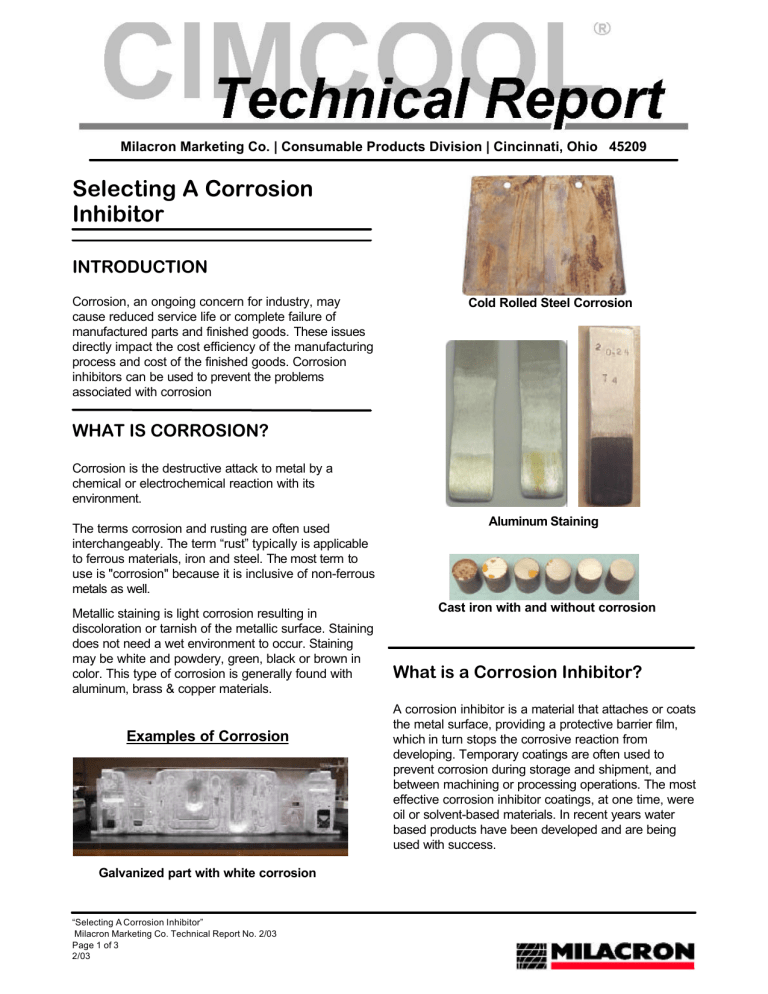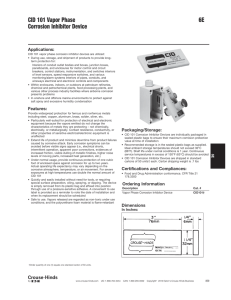Selecting A Corrosion Inhibitor

Milacron Marketing Co. | Consumable Products Division | Cincinnati, Ohio 45209
Selecting A Corrosion
Inhibitor
INTRODUCTION
Corrosion, an ongoing concern for industry, may cause reduced service life or complete failure of manufactured parts and finished goods. These issues directly impact the cost efficiency of the manufacturing process and cost of the finished goods. Corrosion inhibitors can be used to prevent the problems associated with corrosion
Cold Rolled Steel Corrosion
WHAT IS CORROSION?
Corrosion is the destructive attack to metal by a chemical or electrochemical reaction with its environment.
The terms corrosion and rusting are often used interchangeably. The term “rust” typically is applicable to ferrous materials, iron and steel. The most term to use is "corrosion" because it is inclusive of non-ferrous metals as well.
Metallic staining is light corrosion resulting in discoloration or tarnish of the metallic surface. Staining does not need a wet environment to occur. Staining may be white and powdery, green, black or brown in color. This type of corrosion is generally found with aluminum, brass & copper materials.
Aluminum Staining
Cast iron with and without corrosion
What is a Corrosion Inhibitor?
Examples of Corrosion
A corrosion inhibitor is a material that attaches or coats the metal surface, providing a protective barrier film, which in turn stops the corrosive reaction from developing. Temporary coatings are often used to prevent corrosion during storage and shipment, and between machining or processing operations. The most effective corrosion inhibitor coatings, at one time, were oil or solvent-based materials. In recent years water based products have been developed and are being used with success.
Galvanized part with white corrosion
“Selecting A Corrosion Inhibitor”
Milacron Marketing Co. Technical Report No. 2/03
Page 1 of 3
2/03
CIMCOOL
®
Technical Report
Milacron Marketing Co. | Consumable Products Division | Cincinnati, Ohio 45209
Choosing a Corrosion Inhibitor
Water-Based Inhibitors
When choosing the corrosion inhibitor for your application several things need to be considered.
•
Materials to be protected
•
Protection effectiveness timeframe (1week, 1 month, 1 year, etc.)
•
Method of application (dip, spray, brush, etc.)
•
Type of protection required (in process, storage or shipping)
•
Part handling and fingerprint suppression
•
Type and thickness of coating residue desired
•
Storage, packaging and/or shipping conditions
(temperature, humidity & seasonal conditions)
•
Removal methods (if required)
•
Interaction with subsequent processes, if not removed
•
Environmental, health and safety requirements
•
Type of product (Oil/Solvent or Water-based) desired
Water-based corrosion inhibitors rely on modifying the characteristics of the metal surfaces themselves to decrease their susceptibility to oxidation and corrosion formation. Water-based inhibitors are typically sold as a concentrate and diluted with water for use, making their cost less than most oil/solvent-based products.
Water-based corrosion inhibitors generally have very desirable characteristics. The chemical films formed are thin and typically transparent when dry. Application methods for these coatings include spray, brush or immersion. They are cleaner to use and eliminate concerns of solvent fumes. The films rarely have to be removed prior to subsequent operations but if removal is necessary it is done easily with mild water-based cleaners.
Oil/Solvent-Based Inhibitors
Corrosion inhibitors of this type rely principally on the formation of barrier coatings to prevent water from contacting metal surfaces. These materials are typically used direct from their container without any need for thinning or preparation for use.
Water-based inhibitors can be effective in preventing corrosion for extended periods of time (weeks to months) under reasonable plant storage and protected shipping conditions. Since water-based products work by decreasing the susceptibility of the metal to oxidation rather than by completely excluding water and air, these inhibitors often are not as effective as oil/solvent-based coatings in shipping and outside storage of parts.
For additional information on CIMCOOL
CIMGUARD
Water-based Corrosion Inhibitors refer to Table 2 at the end of this document.
The protective coating they form varies (semi-hard, soft, oily, transparent, colored) with the specific product. Removal methods for these coatings are dependent on the specific product and may vary from the use of an alkaline cleaner or degreaser to the use of a solvent. The coatings can be applied by brush, dip, and spray methods.
Supplemental Protection
For parts that need longer term protection (months to years) or those stored in severe environmental conditions (i.e. outside storage) oil-based inhibitors are preferred due to their heavy film and the water rejecting properties they possess.
For additional information on CIMCOOL
CIMGUARD
Oil/Solvent Based Corrosion Inhibitors refer to Table1 at the end of this document.
Adverse atmospheric conditions encountered during shipping and long-term storage may require more protection for the metal than that provided by oil/solvent or waterbased corrosion inhibitors alone. In these cases Vapor-phase Corrosion Inhibitor (VCI) papers, pellets or films may be used as supplemental protection.
Consult with your regional CIMCOOL
Technical
Service Engineer for specific recommendations, or call
CIMCOOL
Technical Service at 1-513-458-8199.
“Selecting A Corrosion Inhibitor”
Milacron Marketing Co. Technical Report No. 2/03
Page 2 of 3
2/03
Table 1.
CIMCOOL
®
Technical Report
Milacron Marketing Co. | Consumable Products Division | Cincinnati, Ohio 45209
Table 2.
“Selecting A Corrosion Inhibitor”
Milacron Marketing Co. Technical Report No. 2/03
Page 3 of 3
2/03





